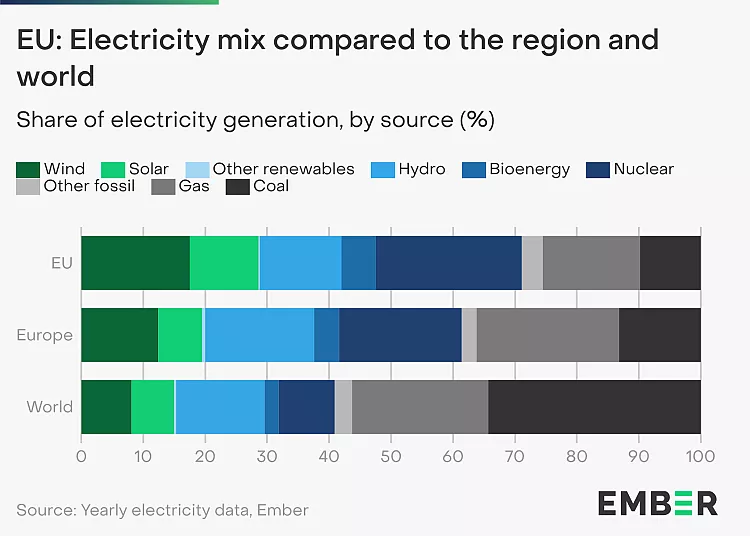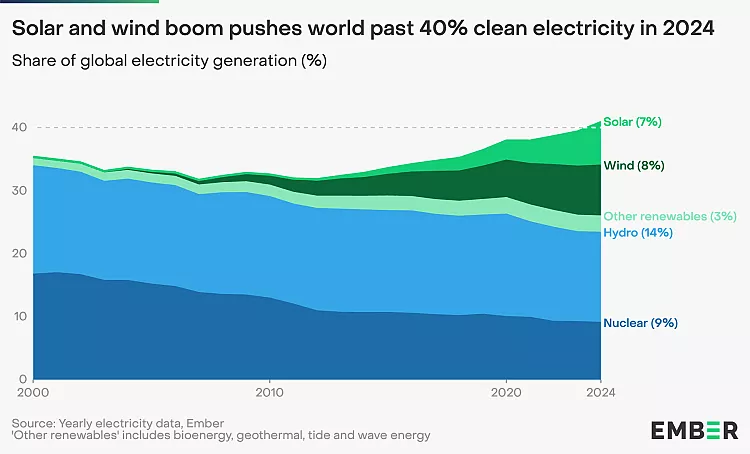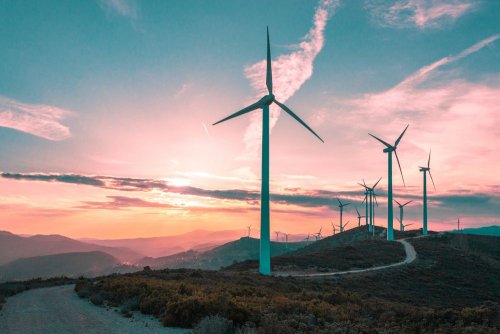Last year, the share of electricity generated by low-carbon sources worldwide was 40.9%, a record first broken since the 1940s.
These data are contained in a new study “Global Electricity Outlook 2025” by the clean energy think tank Ember.
The analysts emphasized that the record was broken even though in the 1940s the global power grid was 50 times smaller than today, and the main work was done by hydropower.
But the study also showed that last year, emissions in the energy sector also reached a historic high. They amounted to 14.6 billion tons of CO2. The authors of the analysis attributed this mainly to the need for cooling technologies during the heat wave, as 2024 was the hottest year on record.
Renewable energy sources (RES)
Renewables added a record 858 TWh of generation in 2024, up 49% from the previous record of 577 TWh set in 2022.
The record growth of renewables combined with a small increase in nuclear generation of 69 TWh resulted in low-carbon energy accounting for 40.9% (12,609 TWh) in 2024, up from 39.4% in 2023.
Hydropower remained the largest source of low-carbon electricity (14.3%), followed by nuclear (9.0%), with wind (8.1%) and solar (6.9%) gaining momentum and together overtaking hydropower in 2024, while the share of nuclear power reached a 45-year low.
Europe is a leader in clean energy
Ember stated that the EU is significantly ahead of the global average: in 2024, the bloc generated 71% of electricity from clean sources, including nuclear power.
“Europe has cemented its global leadership in clean energy,” said Beatrice Petrovic, senior analyst at Ember, in a commentary for Euronews Green.
7 EU member states are among the top 15 countries with the largest share of solar generation in the world. Beatrice Petrovic even called the EU a “solar superpower”.

Shares of electricity generation sources in the EU, Europe and the world. Source: ember-energy.org.
Boom in solar energy use
Solar energy is currently growing rapidly, researchers say. According to Ember's latest global review, global solar generation has become large enough to provide energy for the entire country of India. Over the past three years, solar power generation has doubled to more than 2000 TWh.
For the third year in a row, solar power was the largest source of new electricity generation in the world (+474 TWh) and the fastest growing source of electricity (+29%) for the 20th year in a row.

Source: ember-energy.org.
More than half – 53% – of the increase in solar energy production in 2024 came from China, with the growth of clean generation in this country able to provide 81% of the increase in demand in 2024.
Last year was also a record year in terms of installed solar capacity, with twice as many new plants launched as in 2022. Analysts predict that the rapid growth rate of global solar energy will continue in the future.
Within the EU – its own champions
Researchers say that there are national achievements worth paying attention to. For example, Germany produced 71 TWh of solar energy last year, ranking 6th in the world, and all countries are inferior to China, which produced 834 TWh.
Hungary has the world's highest share of solar energy in the electricity structure – 25%. This result was achieved thanks to a large-scale program to stimulate solar energy in residential buildings, which helped to increase capacity, explains Petrovic.
Spain had the largest growth in solar generation in Europe last year. Its 10 TWh was again eclipsed by China's 250 TWh.
In 2024, China was responsible for more than half of the growth in global electricity production – it gained a staggering 53%.
Recently, EcoPolitic reported that, according to the International Energy Agency, renewables and nuclear power accounted for 80% of the growth in global electricity generation in 2024.
We also reported that on April 1, Finland closed its last coal-fired power plant.





